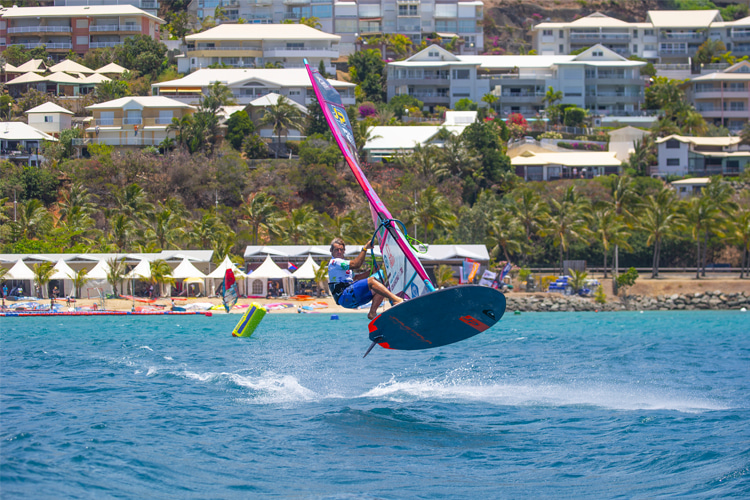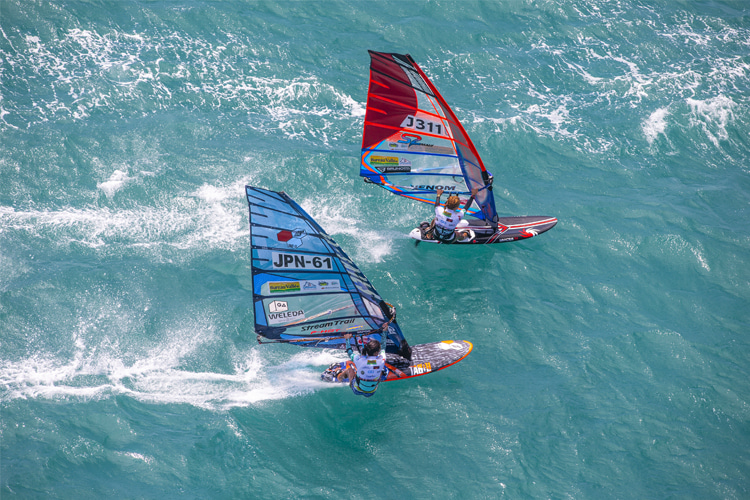Planing is one of the most exciting skills you can master while windsurfing. It usually separates beginners from intermediate and advanced sailors. But what is the minimum wind speed to get flying over water?
One of the good things about windsurfing is that you don't need much wind to start riding. With a bigger sail, almost anything is possible.
But once you master the basics of sailboarding, it's time to speed up.
Planing - not planning - is a technique that opens up a new territory of exploration, speed, and adrenaline-burning rush.
It is a dynamic aspect of windsurfing that elevates the experience from just cruising on water to a sensation akin to hovering above it.
Picture yourself on a windsurfing board, initially slicing through the water at low speed.
As the wind picks up and your speed increases, a shift occurs - your board starts to rise and skim over the surface.
This transformation from merely moving through the water to smoothly sailing above water is what defines planing.

The Planing State
Successfully transitioning into planing is not just about going fast; it's about the right technique and harnessing wind power efficiently.
It involves creating a strong force in the sail by standing upright and leaning into the wind effectively, utilizing your body weight to balance against the sail's pull.
Then, changing direction is key.
Moving from a crosswind course to upwind helps optimize the lift from the sail while reducing resistance.
Your stance is crucial.
You should lean back, away from the mast, to expose more of the sail to the wind. This position aids in exerting a horizontal force on the board.
Keeping your body stiff at this moment is vital.
A relaxed posture would mean losing the necessary momentum for planing, as the energy gets dissipated instead of being transferred to the board.
The final step involves pushing forward with the front foot.
This action, coupled with keeping your hips forward, is essential in sustaining the planing position.
Minimum Speed for Planing
Determining the minimum wind speed required to start planing in windsurfing can be complex, as it depends on various factors such as the windsurfer's weight, skill level, equipment used, and even water conditions.
However, we can draw some general conclusions:
- Wind Speed: Planing in winds under 10 knots is considered challenging, especially for heavier windsurfers. It often requires specific equipment like wider boards and large sails over 7 square meters. On average, a windsurfer can get planning in the 10-16-knot wind speed range. With lighter equipment, meaning a short board and small sail, the wind speed requirement for planing goes up;
- Equipment: The volume of the board is a significant factor. For example, a windsurfer weighing around 200 pounds (90 kilograms) might need a wider and longer board to plane in about 12 to 18 knots of wind, than a lighter rider. In theory, the larger the sail, the faster you could go, meaning you'll start planing with less wind power than those on smaller sails. Being able to use the harness is also critical. If you cannot hook in and out, you'll need to practice the technique before trying to plane;
- Technique: The technique, including board trim and mast track position, greatly influences early planing. Full-body pumping the sail, for instance, can help get the board planing more quickly. A good stance changes everything, so finding the optimal balance between foot and leg pressure is paramount, as well as in-and-out foot strap management;
- Experience: As a general rule of thumb, planing typically starts at wind speeds of around 14 knots or higher. However, this can vary based on individual circumstances like weight, experience, and equipment. For some, planing might be possible in 10-12 knots of wind with the right conditions and technique;
- Other Factors: Besides equipment and technique, local environmental factors, such as the typical wind patterns (stable or gusty) and water conditions (choppy or glassy), also play a role in determining the minimum wind speed for planing;
So, although there's no strict formula, equation, or one-size-fits-all answer for knowing exactly the minimum wind power needed to get planing, you know that with intermediate experience, average-sized equipment, and average weight, you can start flying above the water in 12 knots of wind.
In other words, planning in windsurfing becomes a reality in the 3-4 categories of the Beaufort Wind Force Scale.
